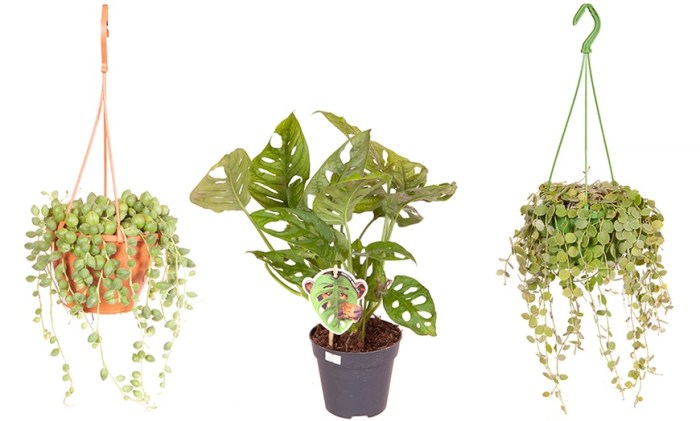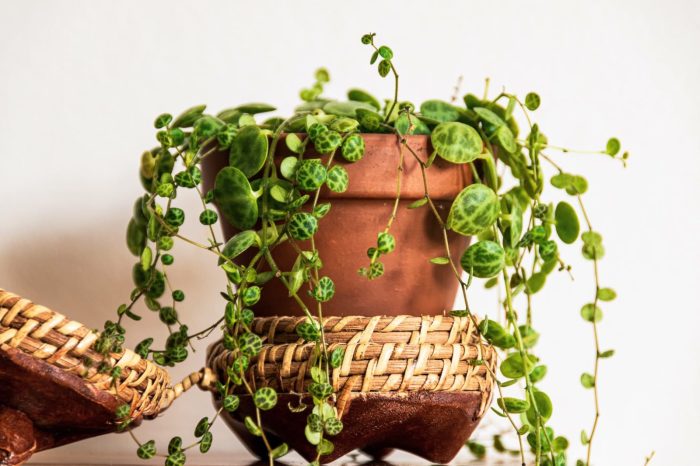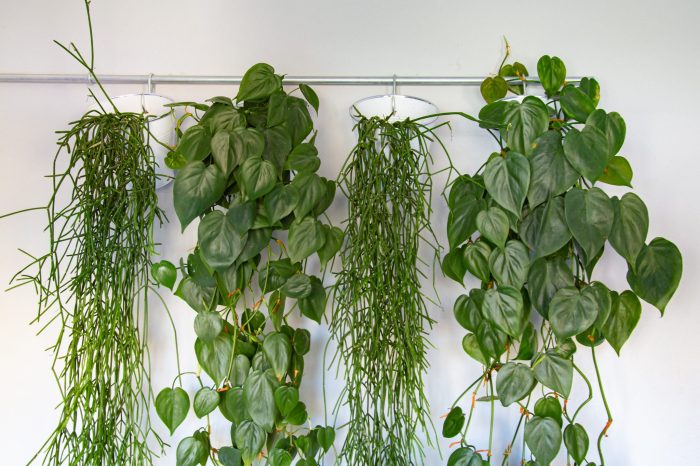Trailing house plants, with their cascading foliage and air-purifying qualities, are gaining immense popularity as indoor décor and health-boosting companions. This comprehensive guide delves into the world of trailing house plants, providing expert advice on care, selection, styling, and the myriad benefits they offer.
From understanding their specific needs to propagating and repotting techniques, this guide equips you with the knowledge to nurture your trailing house plants and keep them thriving.
Plant Care and Maintenance

Trailing house plants, known for their cascading foliage, require specific care to thrive indoors. Understanding their watering, sunlight, and humidity needs is crucial for their well-being.
Watering
Water trailing house plants when the top inch of soil feels dry to the touch. Avoid overwatering, as this can lead to root rot. Use lukewarm water and allow the excess to drain away from the pot.
Sunlight
Trailing house plants prefer bright, indirect light. Avoid placing them in direct sunlight, as this can scorch their leaves. East- or west-facing windows are ideal locations.
Humidity
Trailing house plants appreciate high humidity levels. Misting them regularly or placing them on a pebble tray filled with water can help increase humidity.
Plant Selection and Styling

Trailing house plants add a touch of elegance and natural beauty to any space. With their long, cascading stems and lush foliage, they create a sense of movement and drama. There are many different types of trailing house plants to choose from, each with its own unique growth habit, leaf shape, and color.
Trailing house plants add a touch of elegance and natural beauty to any home. For those seeking a stylish way to display their trailing plants, the triflora hanging planter is an excellent choice. Its unique design and durable construction make it an ideal solution for showcasing trailing plants in a modern and sophisticated manner.
With its versatility, the triflora hanging planter can seamlessly complement various home décor styles, enhancing the ambiance of any room.
Choosing the Right Trailing House Plant
When choosing a trailing house plant, it is important to consider the size and shape of the space where it will be placed. Trailing plants can range in size from small, delicate varieties to large, sprawling plants. It is also important to consider the amount of light that the plant will receive.
Some trailing plants, such as pothos and spider plants, can tolerate low light conditions, while others, such as hoyas and philodendrons, need more light to thrive.
Trailing house plants, with their long, cascading stems, add a touch of elegance and greenery to any room. If you’re looking for a low-maintenance option, consider indoor hanging plants low light . These plants thrive in indirect light and require minimal watering, making them perfect for busy individuals or those with limited natural light in their homes.
From the delicate tendrils of the spider plant to the lush foliage of the pothos, there’s a trailing house plant to suit every taste and decor style.
Once you have considered the size and light requirements of the space where you will be placing the plant, you can start to narrow down your choices. Here is a table comparing some of the most popular types of trailing house plants:
| Plant | Growth Habit | Leaf Shape | Color |
|---|---|---|---|
| Pothos | Vining | Heart-shaped | Green, variegated |
| Spider Plant | Vining | Long and narrow | Green, variegated |
| Hoya | Trailing | Oval | Green, variegated |
| Philodendron | Trailing | Heart-shaped | Green, variegated |
| String of Pearls | Trailing | Round | Green |
| String of Hearts | Trailing | Heart-shaped | Green, variegated |
Once you have chosen a trailing house plant, you can start to think about how you will style it. Trailing plants can be hung in baskets, placed on shelves, or trained to climb trellises. They can also be used to create living walls or screens.
Styling Trailing House Plants
Here are a few ideas for styling trailing house plants:
- Hang trailing plants in baskets from the ceiling or from hooks on the wall.
- Place trailing plants on shelves or tables, allowing their stems to cascade over the edges.
- Train trailing plants to climb trellises or other supports, creating a vertical display.
- Use trailing plants to create living walls or screens, adding a touch of greenery to any space.
With a little creativity, you can use trailing house plants to add a touch of beauty and elegance to any space.
Plant Decor and Aesthetics
Trailing house plants are not only beautiful, but they can also add a touch of elegance and sophistication to any room. Their long, flowing vines can create a dramatic effect, and their lush foliage can help to purify the air.
Whether you’re looking to create a tropical oasis or a cozy retreat, trailing house plants are a great way to add some life to your home.
Using Trailing House Plants to Create Different Atmospheres
Trailing house plants can be used to create a variety of different atmospheres in your home. For example, a hanging basket of ivy can create a sense of tranquility and relaxation, while a trailing plant on a shelf can add a touch of drama and excitement.
You can also use trailing house plants to create a tropical oasis by grouping them together in a corner of your room and adding some colorful flowers.
Complementing Other Home Decor Elements
Trailing house plants can be used to complement other home decor elements, such as furniture, artwork, and textiles. For example, a trailing plant on a coffee table can add a touch of greenery to the space, while a trailing plant on a shelf can help to draw the eye to a favorite piece of art.
You can also use trailing house plants to add a touch of color to a room by choosing plants with brightly colored foliage.
Plant Health and Benefits
Incorporating trailing house plants into your home decor can provide a range of health benefits, enhancing both your physical and mental well-being. These benefits are backed by scientific research and studies.
Improved Air Quality
Trailing house plants act as natural air purifiers, effectively removing harmful pollutants and toxins from the air. Studies have shown that certain species, such as Spider Plants and Peace Lilies, are particularly effective in absorbing volatile organic compounds (VOCs) like formaldehyde and benzene, which can cause respiratory problems and other health issues.
Reduced Stress and Anxiety
Research suggests that the presence of plants in indoor environments can have a calming and restorative effect on individuals. Interacting with plants, whether through visual contact or tactile experiences, has been shown to reduce stress levels, lower blood pressure, and promote relaxation.
Studies have demonstrated that exposure to green spaces, including indoor plants, can trigger a physiological response in the body, leading to a decrease in cortisol, the stress hormone.
Enhanced Cognitive Function
Studies have also found that being around plants can improve cognitive function and concentration. The presence of greenery in the workplace or study environment has been linked to increased productivity, creativity, and problem-solving abilities. Plants provide a visual break, allowing the eyes to rest and reducing mental fatigue.
Importance of Proper Plant Care
To maintain the health and longevity of trailing house plants, proper care is essential. This includes providing adequate sunlight, watering, and nutrients. Neglecting these care requirements can weaken plants, making them more susceptible to pests and diseases. Regular monitoring of plant health, such as checking for yellowing leaves or pests, is crucial for early detection and treatment.
DIY Projects and Inspiration: Trailing House Plant

DIY projects and inspiration can enhance the beauty of trailing house plants and add a personal touch to your home decor. Unleash your creativity with these unique ideas.
Creating a Hanging Planter or Macrame Hanger
Create a stylish and space-saving display for your trailing plants by making your own hanging planter or macrame hanger. Gather materials like a pot, rope, or macrame cord and follow these steps:
- Drill holes in the pot for drainage and suspension.
- Cut the rope or cord into desired lengths and tie it to the pot’s holes.
- Knot the cords together to form a secure hanging mechanism.
- Add your trailing plant and enjoy the elevated greenery.
Unique Display Ideas
Showcase your trailing plants in unconventional ways to create a captivating visual impact. Try these ideas:
- Repurpose old baskets or crates as hanging planters.
- Create a plant wall by mounting shelves or attaching plants directly to the wall.
- Hang trailing plants from a curtain rod or a tension rod for a cascading effect.
DIY Projects Incorporating Trailing House Plants
Take your plant passion to the next level with these DIY projects that incorporate trailing house plants:
- Build a terrarium to create a miniature ecosystem for your plants.
- Transform an old picture frame into a living picture frame by attaching trailing plants to the backing.
- Create a hanging planter made from recycled materials, such as plastic bottles or wooden pallets.
Closing Summary
Incorporating trailing house plants into your home not only enhances its aesthetic appeal but also promotes well-being. By following the guidance provided in this article, you can create a flourishing indoor oasis that purifies the air, reduces stress, and adds a touch of natural beauty to your living space.
Expert Answers
How often should I water my trailing house plant?
Water your trailing house plant when the top inch of soil feels dry to the touch.
What is the best way to propagate a trailing house plant?
Trailing house plants can be propagated by stem cuttings or division.
What are common pests and diseases that affect trailing house plants?
Common pests include aphids, mealybugs, and spider mites. Common diseases include root rot and powdery mildew.